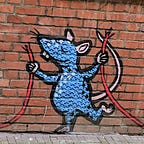Munger Games
Whenever I see a headline mentioning the University of California, my former employer, I pause to scan the story. One of the fun parts about being risk manager at the Berkeley campus was knowing the stuff that couldn’t be publicly revealed due to attorney-client privilege, privacy statutes protecting employees and students, etc. But sometimes that was also a source of frustration, because media accounts were often incomplete or incorrect and we were helpless to stop misperceptions from spreading.
For that reason — I’m an outsider now and realize how much I may not know — I hesitate to join the chorus lashing the University of California-Santa Barbara for building a 1.7 million square-foot, 4,500 student mega-dormitory to the peculiar specifications of 97 year-old billionaire and architectural dabbler Charles Munger. Those specifications include housing 94% of the residents in tiny rooms that provide no natural light or air.
I also hesitate to criticize because I understand the pressure UC-Santa Barbara is under to add student housing (the pressure is even greater at UC-Berkeley), and how hard it would be to turn down Munger’s $200 million donation toward the project in a time of state disinvestment in higher education.
That said: WTF UCSB???
Toward the end of my career one of my duties was to alert leadership to emerging risks that might hit the campus in coming months or years. I built one presentation around the work of San Diego State University psychology professor Jean Twenge, who specializes in the challenges presented by Generation Z, those born between 1995 and 2012 and raised on smartphones and social media. Assuming Twenge’s findings go beyond correlation to causation (inconclusive as yet), the current model of student risk mitigation, aimed primarily at reducing sexual harassment/assault, alcohol abuse, and untreated mental illness, will have to change. Gen Z students date less and drink less, but spend more time “on their phone, in their room, alone and often distressed,” rendering them acutely susceptible to loneliness, depression, and suicide. According to the Centers for Disease Control, the suicide rate among Americans ages 10 to 24 leaped from 6.8 per 100,000 in 2007 to 10.7 in 2018.
I can see how Munger, who started attending college during World War II, would say of his residence hall, “it’s a pretty cheerful place, these little bedrooms” and not grasp how much student sensibilities have evolved. And I can see how he would think endowing common areas with natural light and free-circulating air would lure students out of their cells. But I’m a lot younger than Munger (there aren’t many people I can say that about anymore) and can still recall my psychological state at that age. If my mood wasn’t swinging, my pulse needed checking. Had my abyssal lows been compounded by isolation, which I preferred when I was down, I may not have committed suicide, but almost certainly would have self-destructed in a lesser fashion.
Real architects take as axiomatic that natural light promotes comfort, productivity, and well-being. Who doesn’t want a room with a view? I can’t tell you how often I sat back from my desk at work and stared out my office window, even when all I could see were concrete planter boxes and napping homeless people. Though clad in the carapace of adulthood, I needed those respites, that additional distance from my own worst thoughts. The need is exponentially greater in undergraduates. But UC-Santa Barbara sounds like it intends to proceed with its “architecture of cruelty,” as Los Angeles Times columnist Carolina Miranda calls Munger Hall. Perhaps the state fire marshal or architect can stop the project, especially if purported deficiencies in emergency egress are true. If not, I think the campus needs to begin re-designing its student risk strategies sooner than later. Lives will depend on it.
